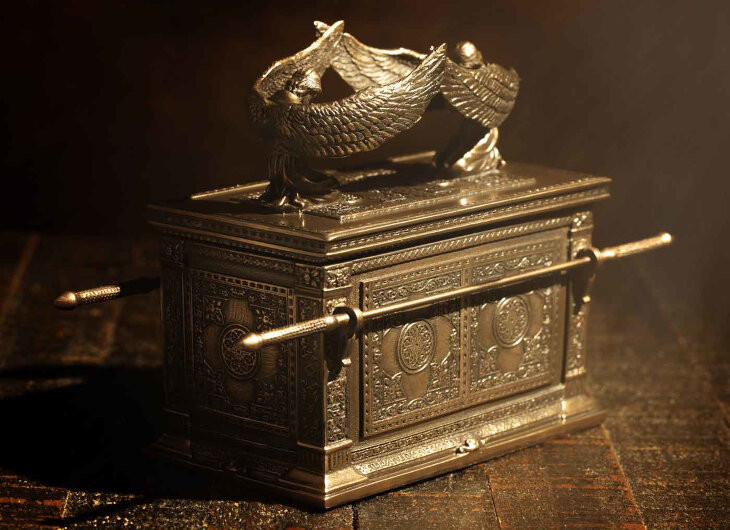The Ark of the Covenant, a sacred chest of immense religious significance, has captivated historians, theologians, and adventurers for centuries. Described in detail in the Book of Exodus, this gold-covered acacia wood box housed the tablets of the Ten Commandments and played a pivotal role in ancient Israelite spiritual life. But Where Is The Ark Of The Covenant Today? This question has fueled countless theories and expeditions, as the Bible itself remains silent on its ultimate fate after the Babylonian conquest of Jerusalem.
The Historical Significance of the Ark of the Covenant
Constructed according to divine instructions (Exodus 25:10-22), the Ark was more than just a container. It was meticulously crafted from acacia wood and overlaid with gold, both inside and out. Its lid, made of solid gold, featured two cherubim facing each other, their wings outstretched. While estimations vary, the gold cover alone may have weighed a substantial amount, potentially hundreds or even thousands of pounds depending on the thickness calculations. Gold-covered poles allowed for its transportation, emphasizing its mobile nature during the Israelites’ wanderings.
According to the Torah, the Ark’s primary contents were the two tablets of the Ten Commandments given to Moses by God (Exodus 31:18). These included the broken fragments of the first set, shattered by Moses upon witnessing the Golden Calf (Exodus 32:19), and the second set he later carved (Exodus 34:1). Jewish tradition also suggests a Torah scroll written by Moses was placed within the Ark.
The Ark’s presence permeated numerous key events in the Hebrew Bible. It led the Israelites across the Jordan River into the Promised Land (Joshua 3) and was instrumental in the conquest of Jericho (Joshua 6). It served as a focal point during times of national crisis, such as the civil war described in Judges 20:27. Even when captured by the Philistines (1 Samuel 4-6), its power was undeniable, as plagues afflicted the captors until the Ark’s return.
 Illustration depicting the Ark of the Covenant being carried by priests, highlighting its central role in ancient Jewish rituals and processions.
Illustration depicting the Ark of the Covenant being carried by priests, highlighting its central role in ancient Jewish rituals and processions.
The Ark resided in the Tabernacle, a portable sanctuary, for approximately four centuries, becoming the epicenter of Jewish spiritual life. When King Solomon built the First Temple in Jerusalem (1 Kings 6-8), the Ark found its permanent home in the Temple’s innermost chamber, the Holy of Holies. This space, especially in the First Temple, was considered the most sacred place in Judaism.
The Mystery of the Ark’s Disappearance
Ironically, the Ark is conspicuously absent from the detailed account in the Book of Kings (2 Kings 25) describing the Babylonian destruction of Jerusalem and the Temple in 586 BCE. While Temple treasures are listed among the spoils taken to Babylon, the Ark is not mentioned.
This omission, according to Jewish tradition, is deliberate and suggests the Ark was likely hidden prior to the Babylonian invasion.
One prominent theory posits that King Josiah, a righteous ruler and reformer (2 Kings 22), foresaw the impending destruction and ordered the Ark to be concealed. It is believed that Josiah hid the Ark, along with other sacred artifacts like the jar of manna (Exodus 16:32-34), the anointing oil (Exodus 30:22-33), and Aaron’s staff (Numbers 17:25), to protect them from desecration.
However, an alternative view proposes that the Ark was indeed taken to Babylon. This theory cites Chronicles II 36:10, which states that King Nebuchadnezzar exiled King Jeconiah to Babylon “with the precious utensils of the House of God.” Proponents of this theory argue that the Ark could have been considered one of these “precious utensils.”
The Ark’s Absence in the Second Temple
Regardless of whether it was hidden or taken, the Ark was not present in the Second Temple, built after the Jews returned from Babylonian exile. The Holy of Holies in the Second Temple remained empty, a stark reminder of what was lost. Consequently, when the Romans destroyed the Second Temple in 70 CE, the Ark was not among the treasures they seized.
The Second Temple was notably different from the First. Beyond the missing Ark, it lacked other elements considered signs of divine presence, including the Shechinah (God’s tangible presence), the divine fire, and the Urim and Thummim (oracular devices). While Temple services continued, the Second Temple was perceived as less sanctified than its predecessor.
Theories on the Current Location of the Ark of the Covenant
The absence of definitive historical records has given rise to numerous theories about where the Ark of the Covenant might be hidden today.
Hidden Beneath the Temple Mount?
One popular theory suggests the Ark remains hidden beneath the Temple Mount in Jerusalem. According to this idea, King Solomon constructed a network of tunnels and chambers beneath the Temple, including a designated hiding place for the Ark in anticipation of potential destruction. It is believed that King Josiah utilized this very system to conceal the Ark. The Talmud also mentions the Tabernacle being hidden within tunnels beneath the Temple Mount. While there have been attempts to explore this area in modern times, the politically sensitive nature of the Temple Mount has hindered extensive excavations.
Concealed on Mount Nebo?
Another theory, found in Maccabees II 2:4-10, points to the prophet Jeremiah as the one who hid the Ark. According to this account, Jeremiah, foreseeing the Babylonian invasion, removed the Ark and other sacred items from the Temple and hid them in a cave on Mount Nebo, the mountain from which Moses viewed the Promised Land, located in modern-day Jordan.
The Ethiopian Claim
A more exotic theory places the Ark in Ethiopia. The Ethiopian epic Kebra Nagast tells the story of Menelik I, son of King Solomon and the Queen of Sheba. According to this legend, Menelik, during a visit to his father, was accompanied on his return journey by Israelite nobles’ sons who secretly stole the Ark and brought it to Ethiopia. When Menelik discovered the theft, he believed it was God’s will for the Ark to remain in Ethiopia, as its power hadn’t harmed his entourage.
It is claimed that the Ark is currently housed in the Church of Our Lady Mary of Zion in Aksum, Ethiopia, guarded by a select monk who is the only person allowed to see it. However, scholars like Edward Ullendorff, who examined the purported Ark during World War II, found it to be a replica, similar to those found in many Ethiopian churches, and not the ancient Ark of the Covenant. Despite this, and other academic challenges, the Ethiopian claim persists.
 A monk standing near a structure in Ethiopia, often mistakenly associated with guarding the Ark of the Covenant, though scholarly evidence suggests otherwise.Is this Ethiopian monk guarding the Ark of the Covenant? Don’t bet on it.
A monk standing near a structure in Ethiopia, often mistakenly associated with guarding the Ark of the Covenant, though scholarly evidence suggests otherwise.Is this Ethiopian monk guarding the Ark of the Covenant? Don’t bet on it.
The Enduring Significance of the Ark
Regardless of its physical whereabouts, the Ark of the Covenant continues to hold immense symbolic and spiritual importance. As a container for the tablets of the Ten Commandments and, according to tradition, the Torah scroll, it represents the divine law and the covenant between God and the Israelites.
The Ark, despite being the holiest object in Judaism and residing in the most sacred space, held contents – the Torah and commandments – that are accessible to all. This highlights a core tenet of Judaism: spirituality and divine wisdom are not exclusive but are available to anyone seeking a meaningful relationship with God. The Torah, embodied by the Ark, offers guidance for a purposeful life.
Mystically, the Talmud describes the Ark as not occupying space, a concept that symbolizes its role as an interface between the physical and spiritual realms. Engaging with the Torah, symbolized by the Ark, allows individuals to gain a deeper, more spiritual understanding of reality while remaining grounded in the physical world.
FAQs about the Ark of the Covenant
-
Has the Ark of the Covenant been found?
No, despite numerous searches and theories, the Ark of the Covenant has not been definitively found. Excavation attempts beneath the Temple Mount have been made but stalled due to political sensitivities.
-
What was kept inside the Ark of the Covenant?
The Ark primarily held the two sets of tablets of the Ten Commandments given to Moses, including the broken first set and the second set he carved. Jewish tradition also suggests a Torah scroll written by Moses was placed inside.
-
Where was the Ark of the Covenant originally located?
Initially, the Ark was housed in the Tabernacle during the Israelites’ desert wanderings. Later, it was kept in Shiloh for a period before being moved to its permanent location in the Holy of Holies of the First Temple in Jerusalem during King Solomon’s reign. Its current location remains unknown.

